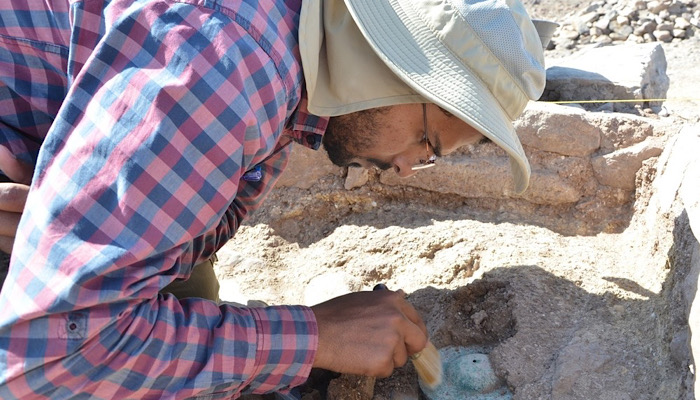
Muscat: The Department of Archaeology at Sultan Qaboos University, under the supervision of the Ministry of Heritage and Tourism (MHT) discovered a pair of complete cymbals made of copper during archaeological excavations at the site of Dahwa 7, located on the outskirts of Wadi Al Sukhn in the Wilayat of Saham, North Al Batinah Governorate.
The abundant archaeological evidence on the surface indicates that the site represents a settlement of a local culture that flourished in the region between 2700 and 2000 BC. After more than 4,000 years of being buried and hidden by the early inhabitants of the Omani Peninsula, archaeological excavations have uncovered them for the first time, revealing cultural secrets and religious beliefs that have been hidden for thousands of years.
The archaeological mission from the Department of Antiquities excavated a number of the settlement's buildings, confirming that the site was very prosperous and that its inhabitants relied heavily on copper mining for their livelihood, in addition to agriculture, especially palm trees, and livestock breeding. The large quantities of imported pottery from the Indus region found within the settlement indicate that the site's inhabitants had close trade relations with the flourishing Harappan civilization there.
Among the four buildings excavated at the site was a small, isolated building, perched atop a high plateau overlooking the rest of the settlement's buildings located in the lower area of the settlement.
Archaeological excavations revealed the general plan of the building, which consists of a rectangular room with a small entrance in its eastern wall, accessed via a rectangular threshold extending along the eastern wall. A number of architectural features were found inside the building, the most important of which was a small stone table located opposite the entrance. The table was constructed of carefully cut thin stones and covered with a layer of yellow plaster.
The architectural features indicate that the building was used as a religious building, and it is one of the oldest temples discovered to date. Archaeological excavations have shown that the building witnessed two main phases of use: an early phase and a late phase. After a period of use, a new floor was built for the building, and a layer of clay was placed underneath.
The cymbals found in this temple are the oldest ever found in the Arabian Peninsula and the Levant. Similar, and perhaps contemporaneous, evidence has been found in the city of Mohenjodaro in the Indus Valley, present-day Pakistan, dating back to the third millennium BC. There is also evidence indicating the use of cymbals in the Sumerian civilization in the city of Ur in southern Mesopotamia.
Archaeological evidence also indicates that the tradition of using cymbals as musical instruments was primarily associated with religious rituals, as they were used in special chants performed during various rituals since the third millennium BC. This indicates that the communities living in the Sultanate of Oman maintained close ties with major civilizations, not only commercially, but also religiously and intellectually.
Geochemical analysis of cymbals from the Dahwa site confirmed that they were made of local copper, possibly brought from an area near Muscat. This discovery is significant not only because of the rarity of these artifacts, but also because of the information it provides about the cultural influences and interactions that existed between distant civilizations.
The results of this discovery were recently published in the UK journal Antiquity, where it has received significant attention from international scientific journals.